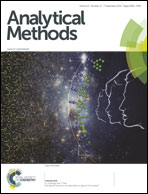Scissor-based fluorescent detection of pepsin using lysozyme-stabilized Au nanoclusters†
Abstract
Pepsin is an active digestive enzyme present in the acidic environment of animal stomachs, and has been widely used to prepare bioactive peptides in the food industry. In this work, a simple fluorescence sensor for scissor-based detection of pepsin activity was developed by using lysozyme-stabilized gold nanoclusters (AuNCs@Lyz) in aqueous media. Under acidic conditions (pH 3.0), enzymatic digestion of AuNCs@Lyz with pepsin results in a significant decrease of fluorescence intensity. Notably, its acidic environment not only helps maintain the maximum fluorescence of gold nanoclusters, but also ensures the highest enzymatic activity of pepsin. In addition to offering high selectivity because of the unique proteolytic action of pepsin under acidic conditions, this facile method provides high sensitivity. With the sensing system, the linear range for pepsin detection is found to be 1 μg mL−1 to 100 μg mL−1, with a detection limit of 0.256 μg mL−1 at a signal-to-noise ratio of 3. Furthermore, the AuNCs@Lyz based fluorescent sensing system could find applications in highly sensitive and selective detection of pepsin in food and biological samples.


 Please wait while we load your content...
Please wait while we load your content...